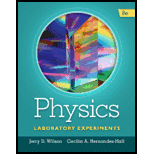
Concept explainers
(a)
The joule heat.
(a)
Answer to Problem 1ASA
Joule heating is the process where the energy of an
Explanation of Solution
Joule heating is the process where the energy of an electric current is converted into heat as it flows through a resistance. Joule's first law or the Joule–Lenz law, states that “the power of heat generated by an electrical conductor is proportional to the product of its resistance and the square of the current”. Despite the fact that it has units of power, it is commonly referred to as joule heat. A given amount of electrical energy absorbed in the resistor produces a fixed amount of heat.
(b)
The
(b)
Answer to Problem 1ASA
The energy is lost in the form of heat.
Explanation of Solution
The expression for joule heat is given by,
Here,
Therefore, the energy is lost in the form of heat. The heat which is produced due to the flow of current within an electric wire is expressed in unit of Joules.
Want to see more full solutions like this?
Chapter 27 Solutions
Physics Laboratory Experiments
- Residential building codes typically require the useof 12 - gauge copper wire (diameter 0.205 cm) for wiring receptacles.Such circuits carry currents as large as 20.0 A. If a wireof smaller diameter (with a higher gauge number) carried thatmuch current, the wire could rise to a high temperature andcause a fire. (a) Calculate the rate at which internal energy isproduced in 1.00 m of 12 - gauge copper wire carrying 20.0 A.(b) Repeat the calculation for a 12 - gauge aluminum wire.(c) Explain whether a 12 - gauge aluminum wire would be assafe as a copper wire.arrow_forwardHow much time is needed for a surgical cauterizer to raise the temperature of 1.00 g of tissue from 37.0ºC to 100ºC and then boil away 0.500 g of water, if it puts out 2.00 mA at 15.0 kV? Ignore heat transfer to the surroundings. How do I check my work for this probelm?arrow_forwardWe have referred to resistorsdissipat-ingheat, i.e., we have assumed thatP=I∆V is always greater than zero. Could I∆V come out to be negative for a resistor? If so, couldone make a refrigerator by hooking up a resistorin such a way that it absorbed heat instead ofdissipating it?arrow_forward
- Explain why birds can sit on power lines safely, eventhough the wires have no insulation around them, whereasleaning a metal ladder up against a power line is extremelydangerous.arrow_forwardIn about 5 sentences can you please explain to me that is the Heat Current “H” the same or different when someone is sitting on the metal or wooden bench?arrow_forwardFor the loop shown in Fig. 6-3, what isVtremf=? N = 20, b = 10 cm, and ω = 10^6 rad/s ...arrow_forward
- A 17-V storage battery delivers current at the rate of 55 A. In a 26-min period, the heat lost from the battery is 108.71 kJ. What is the change in internal energy in kJ of the battery for the discharging period?arrow_forward10.RTD and thermistor work according to the same principle in which the increase in temperature causes the resistance of the sensor to increase. o True o Falsearrow_forwardAssuming that β remained constant, what would be the resistance of the thermistor in the experiment as the temperature approached absolute zero?arrow_forward
- How does temperature affect resistance? Can thermal expansion explain the non-ohmic behavior, why? What happens at the atomic level that accounts for the non-ohmic property?arrow_forwardSuppose the energy transferred to a dead battery duringcharging is W. The recharged battery is then used until fullydischarged again. Is the total energy transferred out of thebattery during use also W ?arrow_forwardAn electronic device designed to operate at any temperature in the range from 10.0C to 55.0C contains pure carbon resistors. By what factor does their resistance increase over this range?arrow_forward

 Physics for Scientists and Engineers with Modern ...PhysicsISBN:9781337553292Author:Raymond A. Serway, John W. JewettPublisher:Cengage Learning
Physics for Scientists and Engineers with Modern ...PhysicsISBN:9781337553292Author:Raymond A. Serway, John W. JewettPublisher:Cengage Learning Principles of Physics: A Calculus-Based TextPhysicsISBN:9781133104261Author:Raymond A. Serway, John W. JewettPublisher:Cengage Learning
Principles of Physics: A Calculus-Based TextPhysicsISBN:9781133104261Author:Raymond A. Serway, John W. JewettPublisher:Cengage Learning


